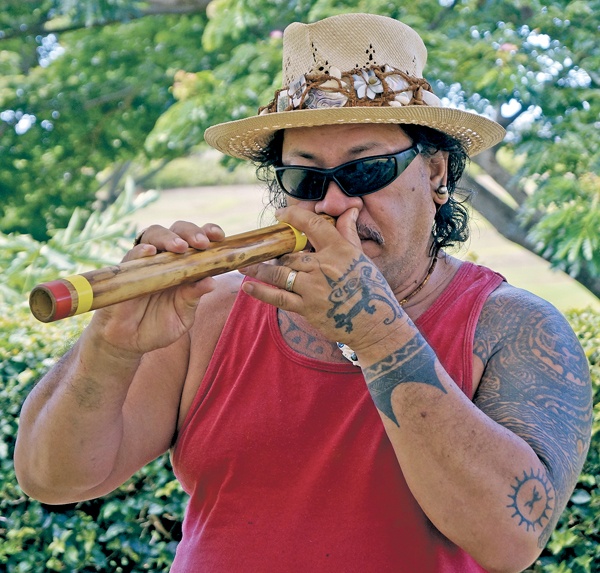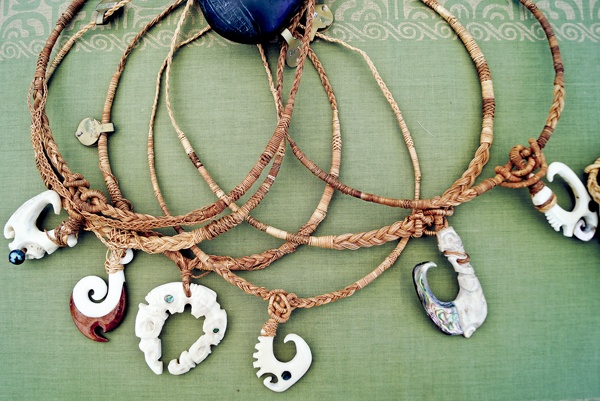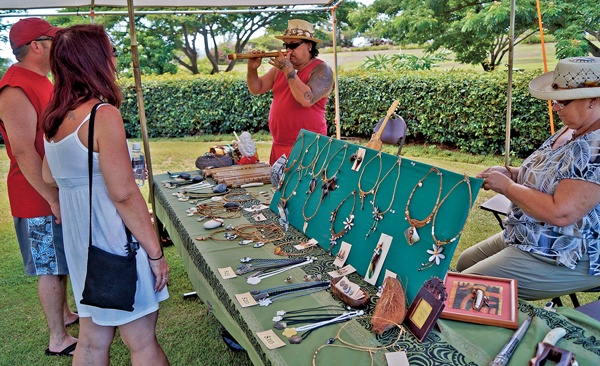PO‘IPU — The crisp, clear sound of a bass drum and the unmistakable stucco rap of a toere summoned from the parking lot at the National Tropical Botanical Garden Visitor Center Sunday. The rhythmic stucco beat pulled customers beyond the
PO‘IPU — The crisp, clear sound of a bass drum and the unmistakable stucco rap of a toere summoned from the parking lot at the National Tropical Botanical Garden Visitor Center Sunday.
The rhythmic stucco beat pulled customers beyond the welcoming foliage where Heifara Aiamu and his wife Tish Hopkins-Aiamu anchored a tent set up for the NTBG ‘Ohana Day.
A variety of Polynesian art, including weaponry utilizing items like a marlin’s bill, was on display for guests. Heifara had ample time to stop his impromptu performances to talk to guests about his Polynesian art and intricate coconut fiber weaving.
“He never used to sign his name for a long time,” Tish said. “But one day, he found the ‘Ha’ (from aloha) in (the initials of) his name and since then, he is proud to sign his name.”
Originally from Tahiti, the couple met during the time when Carol Casil-Akau used to host the Tahiti Fete, celebrating the connection of Tahiti and the Pacific Islands with the Hawaiian culture.
“I’m originally from Canada and I met Heifara while I was working at the Kaua‘i Beachboy,” Tish said. “He used to hang out by the pool with the other artisans. We got married and now, we just hang out together.”
Tish said the original Tahiti Fete with Casil-Akau has been replaced by the Heiva I Kaua‘i, and the Polynesian Festival with Kapu Kinimaka-Alquiza.
Heifara, a multi-faceted artisan, demonstrated his prowess on a variety of Polynesian instruments, including the bass drum that Tish said he used to play with a dowel and a tennis ball between his toes.
His toere, a Tahitian log drum fashioned out of milo wood, sports some of his Polynesian art, personalized with abalone inlays. He also makes his own Tahitian ‘ukuleles.
The clarity of sound — even heard from as far away as the parking lot — attests to the quality of the instruments.
At his feet, Heifara had various projects in varying stages of completion, surrounded by some coconut husks.
Almost buried by the husks, a small nail clipper gleamed in the sunlight.
“That’s one of the modern tools he uses to get the coconut fibers,” Tish said. “Each fiber is derived from the husks which have been soaked in the ocean and separated into the fibers which he weaves.”
Those weavings and braiding form the basis of Island Style Kaua‘i “jewelry” offerings, although the couple do not admit to the pieces being jewelry.
“People are affected by them when they wear them,” Tish said. “That’s because each piece is carved by Heifara and it comes from the heart.”
In addition to his musical prowess, carving and weaving skill, Heifara is also a living billboard of his Polynesian art, using his Tahitian background to tattoo himself with designs he creates, Tish said.
“He uses modern tattoo equipment, but the principles are from Tahiti where the unmistakable tap-tap at marketplaces usually announce the presence of tattoo makers,” Tish said. “Heifara is working on designs which go up his leg, right now.” Tish said they had an opportunity to open a shop, but the rent proved to be too expensive.
“We used to be at the Lu‘au Kalamaku‘u, too,” Tish said. “Right now, we do Judy Webb’s artisan fairs in Po‘ipu, and last year, we couldn’t attend the NTBG Christmas Craft Fair because we were in Tahiti, but this year, we’ll be back on the first Sunday in December.”
And true to the traditional roots of Heifara’s Polynesian art, there is no website to visit — just a phone number (822-9552) to call for more information.
• Dennis Fujimoto, photographer and staff writer, can be reached at 245-3681 (ext. 253) or dfujimoto@ thegardenisland.com.




